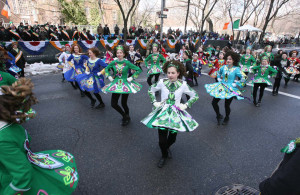Story Behind Holidays
Warning: count(): Parameter must be an array or an object that implements Countable in /home/commcomm/public_html/wpsites/annwp/wp-content/plugins/really-simple-facebook-twitter-share-buttons/really-simple-facebook-twitter-share-buttons.php on line 514
Story Behind Holidays
Valentine’s Day
The Catholic Church recognizes three different saints named Valentine, all of whom were martyred. One legend contends that Valentine was a Roman priest who, during the third century, defied Claudius II when the emperor outlawed marriage for young men, having decided that single men made better soldiers than those with wives and families. Valentine, realizing the injustice of the decree, continued to marry young lovers in secret. When Valentine’s actions were discovered, Claudius ordered him put to death. For his reputation, Valentine would become one of the most popular saints in England and France.
Valentine greetings were popular as far back as the Middle Ages, though written valentines didn’t begin to appear until after 1400. The oldest known valentine still in existence today was a poem written in 1415 by Charles, Duke of Orleans, to his wife while he was imprisoned in the Tower of London following his capture at the Battle of Agincourt. The greeting is now part of the manuscript collection of the British Library in London, England.
It has been estimated that Americans began exchanging hand-made valentines in the early 1700s. In the 1840s, Esther A. Howland began selling the first mass-produced valentines in America. Howland, known as the “Mother of the Valentine,” made elaborate creations with lace, ribbons and colorful pictures known as “scrap.” Today, according to the Greeting Card Association, an estimated 1 billion Valentine’s Day cards are sent each year.
St. Patrick’s Day
Since approximately the ninth or tenth century, people in Ireland have been observing the Roman Catholic feast day of St. Patrick on March 17.
Interestingly, however, the first parade held to honor St. Patrick’s Day took place not in Ireland but in the United States. On March 17, 1762, Irish soldiers serving in the English military marched through New York City, happily received along the sidelines by local residents. Along with their music, the parade helped the soldiers reconnect with their Irish roots, as well as with fellow Irishmen serving in the English army.
In modern-day Ireland, St. Patrick’s Day has traditionally been a religious occasion. In fact, up until the  1970s, Irish laws mandated that pubs be closed on March 17. Beginning in 1995, however, the Irish government began a national campaign to use interest in St. Patrick’s Day to drive tourism and showcase Ireland and Irish culture to the rest of the world. Today, approximately 1 million people annually take part in Ireland’s St. Patrick’s Festival in Dublin, a multi-day celebration featuring parades, concerts, outdoor theater productions and fireworks shows.
1970s, Irish laws mandated that pubs be closed on March 17. Beginning in 1995, however, the Irish government began a national campaign to use interest in St. Patrick’s Day to drive tourism and showcase Ireland and Irish culture to the rest of the world. Today, approximately 1 million people annually take part in Ireland’s St. Patrick’s Festival in Dublin, a multi-day celebration featuring parades, concerts, outdoor theater productions and fireworks shows.
The celebrating has grown contagious: People of all backgrounds celebrate St. Patrick’s Day today, especially throughout the United States, Canada and Australia. Parades and celebrations are held in locations far from Ireland, including Japan, Singapore and Russia, but North America is home to the largest productions, with more than 100 St. Patrick’s Day parades being held across the United States. In 1848, several New York Irish Aid societies decided to unite their parades to form one official New York City St. Patrick’s Day Parade. Today, that parade is the world’s oldest civilian parade and the largest in the United States, with over 150,000 participants. Each year, nearly 3 million people line the 1.5-mile parade route up 5th Avenue from 44th Street to 86th Street to watch the procession, which takes more than five hours. Boston, Chicago, Philadelphia, and Savannah also celebrate with parades involving between 10,000 and 20,000 participants each. How will you celebrate St. Patrick’s Day this year?
For more fun facts about St. Patrick’s Day, click here!
The celebration of Easter historically has beliefs of pagan origin. Scholars believe the name Easter is thought to come from the Scandinavian “Ostra” and the Teutonic “Ostern” or “Eastre.” These are Goddesses of mythology who symbolize spring and fertility. Their festival was celebrated on the day of the vernal equinox, which is the basis for determining which Sunday is Easter.
For Christians, Easter is a religious holiday commemorating the resurrection of Jesus Christ, the son of God. The Christian celebration of Easter represents a few traditions, most notably the relationship of Easter to the Jewish festival of Passover. Passover, a feast in the Jewish calendar celebrated for 8 days, commemorates the flight of the Israelites from slavery in Egypt for freedom. Christian churches in the East were closer to the birthplace of Christianity and old traditions and thus, observe Easter according to the date of the Passover festival.
Today, there are still symbols of birth and renewal in the modern day Easter celebration: The Easter rabbit is a symbol of fertility. Eggs, symbols of the source of life, are colored and painted to represent the sunlight and brightness of spring.
Mother’s Day
The earliest Mother’s Day celebrations have been traced back to springtime festivals in Greece in honor of Rhea, the Mother of the Gods.
In 1872, Julia Howe proposed the first Mother’s Day in the United States. Howe, who is the author of the Battle Hymn of the Republic, suggested it be a day dedicated to peace and she held organized meetings for Mother’s Day in Boston every year.
In 1907 Ana Jarvis of Philadelphia convinced her mother’s church in West Virginia to celebrate Mother’s Day on the anniversary of her mother’s death, the 2nd Sunday of May. Jarvis was very active in writing to public figures in an effort to establish a national Mother’s Day. Her efforts were rewarded in 1911 – Mother’s Day was celebrated in almost every state. In 1914, President Woodrow Wilson, made the official announcement proclaiming Mother’s Day as a national holiday to be held each year on the 2nd Sunday of May.
Graduation
The graduation ceremony is the modern equivalent of ancient rites of passage from youth into adulthood. Commencement is the contemporary way to acknowledge that an important hurdle in life has been cleared. The traditional commencement cap and gown was first worn by US high school graduates in 1908. The gown reflects dress of the late Middle Ages and Renaissance period. The “mortarboard,” a four-sided graduation cap, first appeared in the 16th century in Scottish universities.
 Fourth of July
Fourth of July
On July 4, 1776, the Continental Congress assembled in Philadelphia to announce its Declaration of Independence from England. The Declaration, drafted by Thomas Jefferson, was passed unanimously by the 13 colonies. (New York had originally abstained from the vote, waiting on the decision of its citizens, but voted in favor of the Declaration a week later).
 Father’s Day
Father’s Day
The first known Father’s Day message was carved into clay nearly 4,000 years ago by a Babylonian youth named Elmesu who wished his father good health and a long life. The modern-day inspiration for Father’s Day was William Jackson Smart, a widowed Civil War veteran from Spokane, Washington, who was both father and mother to his six children. His daughter got the idea for Father’s Day in 1909 while listening to a Mother’s Day sermon at church. Although it has been celebrated since the early 1900s, Father’s Day was not made official until 1972 when former President Richard M. Nixon signed a resolution declaring the third Sunday in June as Father’s Day.
 Halloween
Halloween
All Hallows Eve, or the night before All Saints Day, has roots going back to Celtic cultures. Legend has it from the 5th century B.C. that on the last day of Celtic Ireland’s summer, October 31, the spirits of those who had died that year would come out to search for bodies to possess for another year. The living, not wanting to be possessed, would darken their homes to make them uninviting and dress in costume to scare away the spirits. They would then relight their fires from a common source in Usinach, a Druidic fire in the center of Ireland.
The Romans took some of these Celtic traditions as their own – but adapted them. For example, the last night of summer translated into the Roman day to honor Pomona, the Roman goddess of fruit and trees. Does bobbing for apples sound familiar?
It is believed that Trick-or-treating came from the 9th century European custom of “souling.” November 2 was All Souls Day and early Christians went from home to home begging for “soul cakes,” (pieces of bread with currants) and the more they got the more prayers they had to say for the dead.
The Halloween tradition was introduced in America in the 1840’s when Irish immigrants escaping famine arrived in the country.
 Thanksgiving
Thanksgiving
For those of us from New England (and visitors), a trip to Plymouth, MA is a trip back to the very first Thanksgiving. It was in 1621 that the colonists in Plymouth sat down with the Wampanoag Indian tribe after a very difficult arrival in America, and they both shared an autumn harvest feast. As for that historical meal: the pilgrims did not have forks! Meals were eaten with spoons and knives, along with fingers. Salt was available to add to food, but pepper was used only in preparation. While some sugar had made its way over on the boat, most was gone by the time the first Thanksgiving occurred. Thus, while there was plenty of meat and flavorful side dishes, there were no ovens nor was there any sugar for sweets and desserts.
View Blog Page











